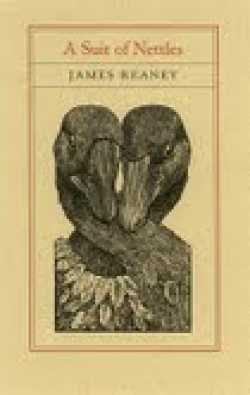A Suit of Nettles
- 2010 INDIES Finalist
- Finalist, Poetry (Adult Nonfiction)
The title of James Reaney’s (1926-2008) book-length poem cycle, A Suit of Nettles, may ring a bell. Some may recall its acclaimed first publication in 1958; others will have read excerpts in the recent Essential James Reaney, also from Porcupine’s Quill (and shortlisted for the 2010 ForeWord Book of the Year prize). Still others will think of a tale from the Brothers Grimm—about a princess who weaves suits of nettles to return six enchanted swans to human form. Yet if this allusion informs Reaney’s work, it is partly by way of contrast. For one thing, his protagonists are geese, not swans. For another, they never were human and never want to be. As the goose Mopsus sardonically puts it: “Here look at man. I’ll draw him in this dung.”
The joke ends up being on Mopsus, of course, when he and several other geese are butchered for Christmas dinner. But if this ending’s implications reflect the work’s scatological bent, they also play into its emphasis on cycles (vicious and otherwise). Echoing Edmund Spenser’s sixteenth-century Shepherd’s Calendar, Reaney divides his work into twelve chapters, one for each month. In keeping with pastoral protocol, these chapters display formally diverse poetic dialogues on a range of themes. Love features prominently, but so do Canadian history, 1950s small-town life, and the conflict between traditional and progressive styles in education. For, whatever the geese think, this is the human world, albeit transformed by Reaney’s pen. Jim Westergard’s witty and elegant engravings in the new edition underscore this point.
Inevitably, given the nature of topical satire, not all of Reaney’s jokes still resonate. And yet, to use one of the book’s own metaphors, the merry-go-round of intellectual fashion sometimes comes full circle. Reaney’s comments on the Great Depression, for instance, now seem freshly relevant. Although it sometimes settles for clever patter, the book’s wit can also embody itself in memorable writing. Highpoints include not only the boisterous invocation to the Muse of Satire, but also lyrics that strike a delicate balance between irony and genuine plaintiveness: “I am like a hollow tree / Where the owl & weasel hide / I am like a hollow tree / Dead in the forest of his brothers.” The resulting book should appeal to a range of readers, including those interested in pastoral, in the work of Reaney’s mentor Northrop Frye, and in Canadian history and literature in general.
Reviewed by
Paul Franz
Disclosure: This article is not an endorsement, but a review. The publisher of this book provided free copies of the book and paid a small fee to have their book reviewed by a professional reviewer. Foreword Reviews and Clarion Reviews make no guarantee that the publisher will receive a positive review. Foreword Magazine, Inc. is disclosing this in accordance with the Federal Trade Commission’s 16 CFR, Part 255.

